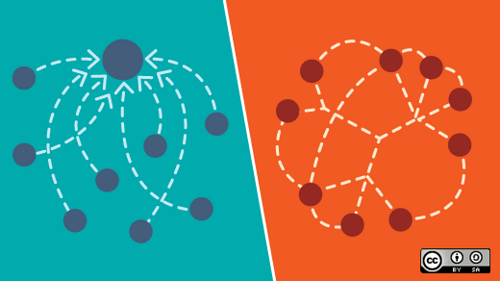You are here
Google Docs - Crowd-Sourcing an Annotated Bibliography
Primary tabs

"2 reasons why the term 'crowdsourcing' bugs me" via opensourceway's Flickr
Using GoogleDocs, students create a group bibliography page to practice summarizing and evaluating a source. They then engage in an informal presentation of their source to the class. By addressing their classmates as an audience, students have an extra level of accountability to their peers to find quality sources and to write about them with care.
Research, citation, group collaboration, awareness of audience, summary
Students will need a Google account in order to access the group document. A media console with projector would be preferable, but strictly-speaking, this lesson does not require classroom technology as students do most of the work from home.
Using GoogleDocs, students create a group bibliography page to practice summarizing and evaluating a source. They then engage in an informal presentation of their source to the class. This collaborative exercise goes against the Lone Researcher model, but it is interesting to track how an article that one student finds stimulates another student's thinking in the final paper. There's also an ethos factor here--by addressing their classmates as an audience, students have an extra level of accountability to their peers to find quality sources and to write about them with care.
This assignment took about two weeks (i.e., less than a unit-length) to complete. 2-3 students would present each day, over the course of about 6 class periods.
After introducing research methods in class, I asked students to find a source related to our texts for the third unit. They signed up for presentation slots available over the course of the next two weeks. On the day of their presentation, their annotated citation was due.
Overview
In 250-400 words, write an annotated citation of a primary or secondary source. Your annotation should include (1) a concise summary and evaluation of the source and (2) an argument about how this source might enhance our reading of Gattaca or Oryx and Crake.
Specifics
This semester, we've examined materials that establish the historical and cultural contexts in which literary texts participate. E.g., we've looked at Lankester's writings on degeneration to understand the bleak evolutionary themes of The Time Machine. We've also consulted visual artifacts, such as late-Victorian cartoons about evolution and representations of genetics on recent magazine covers.
Now it's your turn: find an outside source that illuminates the literary and scientific contexts of Gattaca or Oryx and Crake. A few ideas: an interview with the author/director; an article in Nature or another scientific journal; a scholarly article or book chapter by a literary critic; an advertisement, artwork, film, etc. In class, we will discuss strategies for researching and assessing potential sources.
Regardless of your choice, your annotated citation will have three components: (1) an MLA-style citation, (2) a concise summary of an argument or an evocative description of an artifact, and (3) an argument that connects your source to the film/novel. Although you won't have much space to quote extensively, use specific language and examples to tie your reader closely to the source.
To receive credit for this assignment, you will also informally present your source to the class, summarizing your findings and pointing us to their implications.
Goals
- Demonstrate care in selecting a source.
- Provide a succinct but thorough summary/description of your source.
- Successfully argue for what this source can tell us about the film or novel.
- Clearly present your findings to the class.
Formatting
- Each assignment should be 250-400 words, single-spaced. Include an MLA-style citation in bold at the top of your entry.
- Add your citation to our class's annotated bibliography on GoogleDocs (no hard copy needed).
- In-text citations should be formatted according to MLA style: insert page numbers for any quotations in parentheses after the quote (just the page numbers; no pp. or p.)
This short assignment counted for 6 percent of their total grade. However, the presentation component was evaluated on the basis of completion only, as it was not the focus of the assignment. Strong assignments demonstrated care in selecting a source, provided a succinct but thorough summary/description of the source, and successfully argued for what this source can tell us about the film or novel.
This lesson was used in an introductory literary studies course: E314J - Literature and Biology
What does it mean to be human? Why do we behave the way we do? What’s the difference between life and non-life, organism and machine? Where are we (the human species, the planet Earth) headed next? Acknowledging certain obvious and meaningful differences in methods and outlook, one might nevertheless argue that both writers and biologists travel similar terrain, presenting themselves as (often competing) authorities on the “big questions” about Life. Instead of seeing literature and biology as necessarily antagonistic ways of looking at and understanding the world, we will read literature about science and literary science writing for their complementary insights. What do literature and biology look like at their interface? How do the scientific paradigms of their day influence how writers grapple with questions of human experience, identity, and ethics? In turn, how do literary narratives about evolutionary biology or genetics shape the way we think about these disciplines, the way they’re understood by non-scientists? No expertise in biology or in literary criticism will be presumed. The broad goals of this course will be to introduce science majors to the basic tools of literary analysis as well as to enable non-science majors to be savvier readers of the popular science they encounter. The course’s emphasis on students’ own critical writing will be helpful no matter what your major.
-

- Log in to post comments

